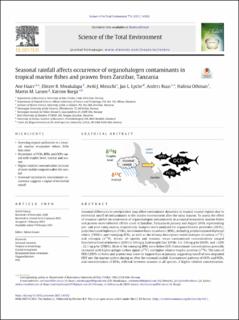Seasonal rainfall affects occurrence of organohalogen contaminants in tropical marine fishes and prawns from Zanzibar, Tanzania
Haarr, Ane; Mwakalapa, Eliezer B; Mmochi, Aviti J; Lyche, Jan L; Ruus, Anders; Othman, Halima; Larsen, Martin M.; Borgå, Katrine
Peer reviewed, Journal article
Published version
Permanent lenke
https://hdl.handle.net/11250/2765286Utgivelsesdato
2021Metadata
Vis full innførselSamlinger
Sammendrag
Seasonal differences in precipitation may affect contaminant dynamics in tropical coastal regions due to terrestrial runoff of contaminants to the marine environment after the rainy seasons. To assess the effect of seasonal rainfall on occurrence of organohalogen contaminants in a coastal ecosystem, marine fishes and prawns were collected off the coast of Zanzibar, Tanzania in January and August 2018, representing pre- and post-rainy season, respectively. Samples were analyzed for organochlorine pesticides (OCPs), polychlorinated biphenyls (PCBs), brominated flame retardants (BFRs), including polybrominated diphenyl ethers (PBDEs) and emerging BFRs, as well as the dietary descriptors stable isotopes of carbon (δ13C) and nitrogen (δ15N). Across all species and seasons, mean contaminant concentrations ranged from below limit of detection (LOD) to 129 ng/g lipid weight (lw) ΣPCBs; 5.6–336 ng/g lw ΣOCPs; and < LOD –22.1 ng/g lw ΣPBDEs. Most of the emerging BFRs were below LOD. Contaminant concentrations generally increased with higher pelagic carbon signal (δ13C) and higher relative trophic position (δ15N). The ratio of DDE/ΣDDTs in fishes and prawns was lower in August than in January, suggesting runoff of non-degraded DDT into the marine system during or after the seasonal rainfall. Contaminant patterns of OCPs and PCBs, and concentrations of BFRs, differed between seasons in all species. A higher relative concentration-increase in lower halogenated, more mobile PCB and PBDE congeners, compared to higher halogenated congeners with lower mobility, between January and August aligns with a signal and effect of terrestrial runoff following the rainy season.
